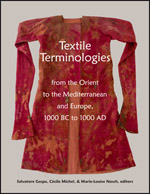Centre for Textile Research
Date of this Version
2017
Document Type
Article
Citation
In Textile Terminologies from the Orient to the Mediterranean and Europe, 1000 BC to 1000 AD, ed. Salvatore Gaspa, Cécile Michel, & Marie-Louise Nosch (Lincoln, NE: Zea Books, 2017), pp. 301-320.
doi:10.13014/K2251GB2
Abstract
In Roman Egypt papyrologists and archaeologists sometimes seem to inhabit two different, if parallel, worlds, each apparently unaware of the treasures to be found in the other. This paper, however, is a co-operative venture between an ancient historian with papyrological interests – Kerstin Droß-Krüpe – and an archaeologist – John Peter Wild. In the research field of textiles we overlap, and we want to offer you insights from each of our worlds. At some point in the later 2nd century AD an unnamed magnate in the territory of the Lingones in central Gaul dictated a will in which he stipulated that a number of his prized possessions should be cremated with him on his funeral pyre. Among those listed are vestes polymitae et plumariae. What do these two textile terms mean? And what did the textiles themselves look like? The images in Figures 1 and 2 are our provisional suggestions. The two items shown here are of wool – they are actually from Roman Egypt – and at first glance they look in decorative terms rather similar to one another;4 but the textile in Figure 1 is in taqueté – vestis polymita, we argue – mechanically woven – while the piece in Figure 2 is in tapestry weave, vestis plumaria, and hand-woven. The structures of the two weaves can be characterised as follows: Tapestry weave, made famous by the Gobelin workshops in Paris, is essentially a mosaic in coloured wool yarns, constructed free-hand, and concealing the underlying warp. The weaver has available on individual spools a selection of dyed yarns which he or she interlaces with the warp threads according to the requirements of the pattern. A distinctive feature of tapestry is the oblique lines or even vertical slits where weft yarns in different colours meet one another and turn back (Fig. 3). Across an area, an accomplished weaver can achieve the subtle, gradual, changes in colour visible in the highest-quality floor and wall-mosaics and in wall painting.
Taqueté, also known as ‘weft-faced compound tabby’ and in German Leinwandschusskompositbildung, aims for a similar decorative effect, but rarely in more than two colours. It is created mechanically by means of a complex planned sequence of different sheds on the loom, which the weaver memorises. The overall decorative scheme is constructed by repeating a single pattern unit, sometime in mirror image. The weave structure can be recognised by the fact that a weft thread in one colour disappears to the reverse side of the cloth behind an adjacent thread in a different colour as the pattern changes, only to re-appear on the obverse again later when it is required (Fig. 4).
A variety of ancient sources can be deployed to inform discussion and argument about textile structure and terminology. Roman inscriptions and papyri in Greek and Latin are crucial documents, but tend to be laconic: both the writer and the reader knew exactly what was meant by a given technical expression, but we are left in the dark. Authors of classical literature write at greater length, and at first sight more helpfully; but their reliability is variable and often difficult to check. Poets, for example, treat of technical matters with artistic licence, especially when the vocabulary does not fit the metre. Scholars who consult another much-quoted source, the late Roman and early medieval encyclopaedists and glossators like Hesychius and Isidore, are well advised to exercise caution: for such compilers may simply be guessing.
Ancient art, particularly funerary art, is a rich source of textile images, but, taken alone, the latter usually lack the necessary detail for precise technical identification. Surviving archaeological textiles are a relatively new and growing resource, and one might expect to find examples of vestis polymita and plumaria somewhere in the extant textile corpus. Both techniques are described explicitly as woven-in, and not decoration added afterwards, so that narrows the range of possibilities.
Included in
Ancient History, Greek and Roman through Late Antiquity Commons, Art and Materials Conservation Commons, Classical Archaeology and Art History Commons, Classical Literature and Philology Commons, Fiber, Textile, and Weaving Arts Commons, Indo-European Linguistics and Philology Commons, Jewish Studies Commons, Museum Studies Commons, Near Eastern Languages and Societies Commons, Other History of Art, Architecture, and Archaeology Commons


Comments
Copyright © 2017 Salvatore Gaspa, Cécile Michel, & Marie-Louise Nosch. Photographs copyright as noted.